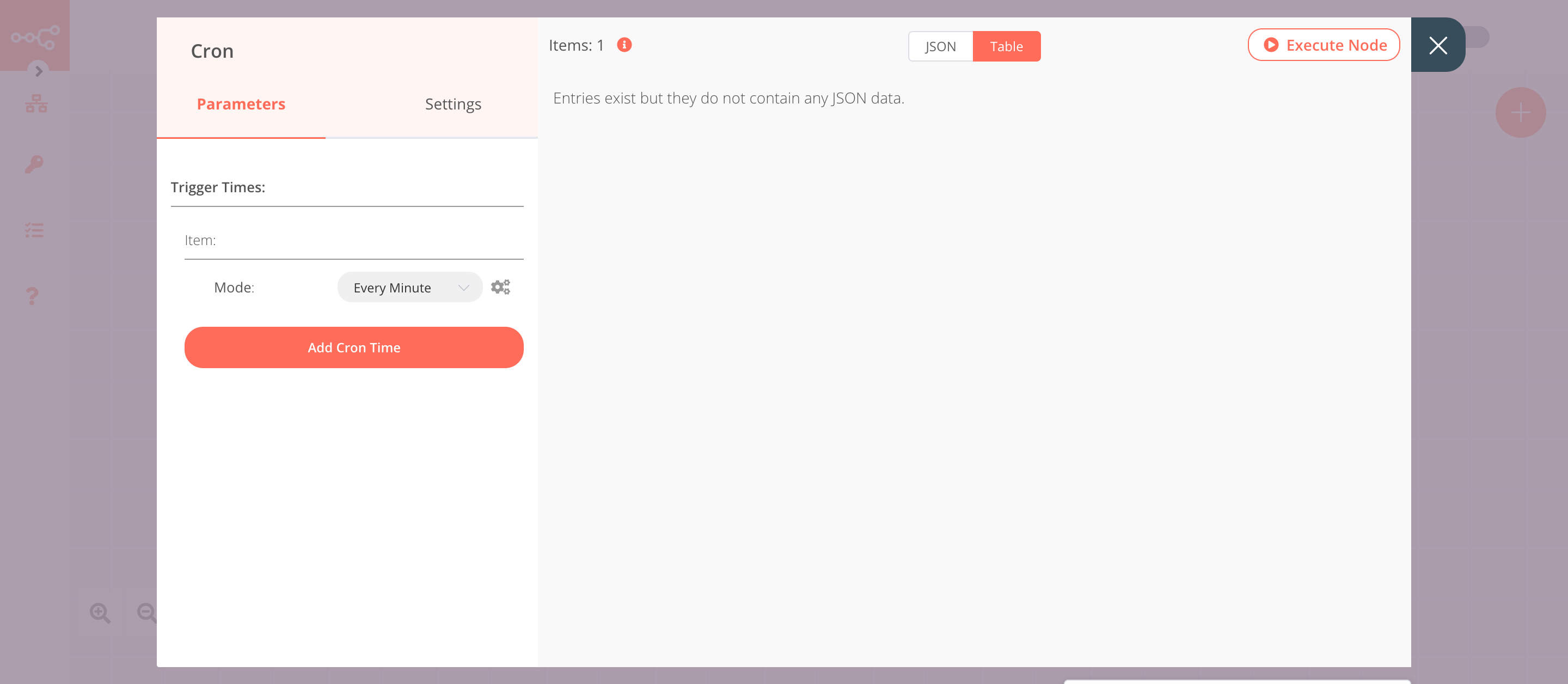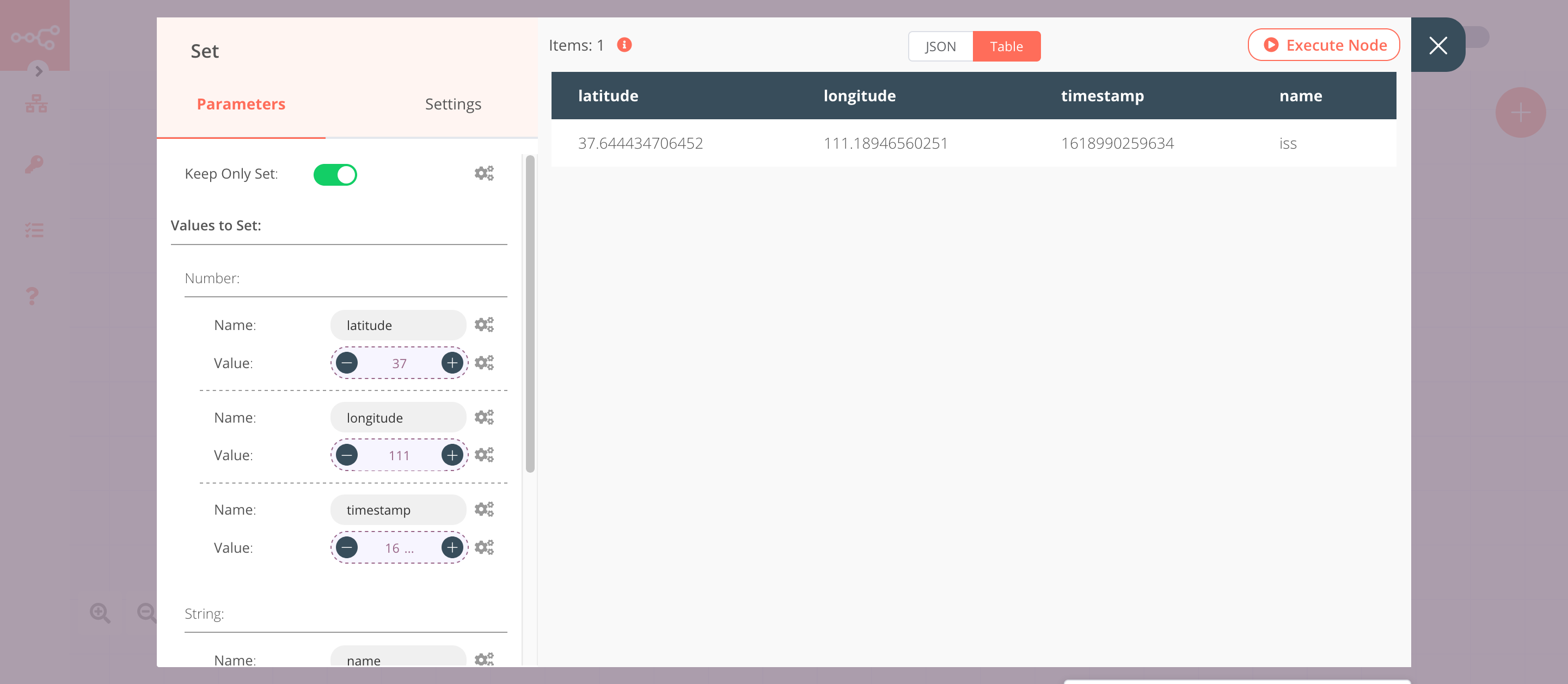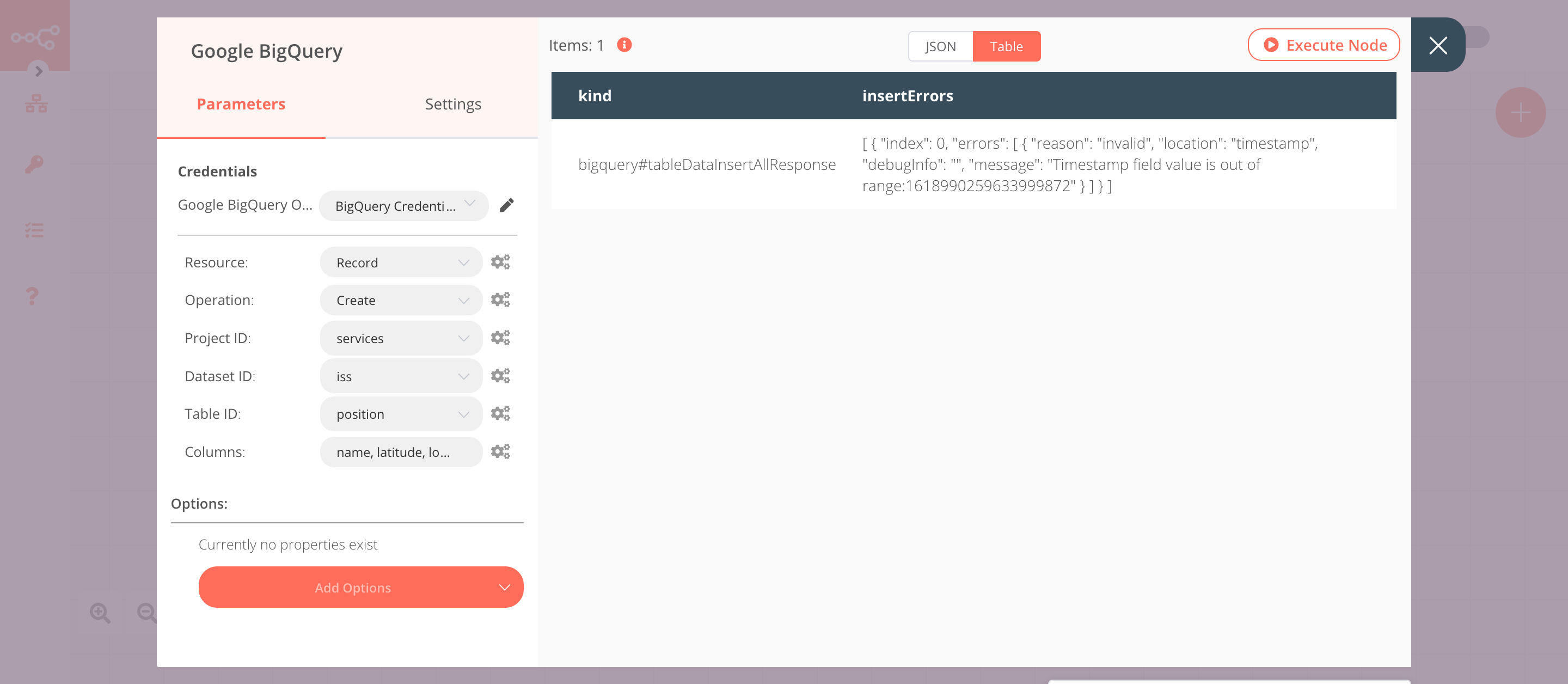Google BigQuery#
The Google BigQuery node allows you to automate work in Google BigQuery, and integrate Google BigQuery with other applications. n8n has built-in support for a wide range of Google BigQuery features, including creating, and retrieving records.
On this page, you'll find a list of operations the Google BigQuery node supports and links to more resources.
Credentials
Refer to Google BigQuery credentials for guidance on setting up authentication.
Examples and templates
For usage examples and templates to help you get started, take a look at n8n's Google BigQuery integrations list.
Basic Operations#
Record
- Create a new record
- Retrieve all records
Example Usage#
This workflow allows you to send position updates of the ISS every minute to a table in Google BigQuery. You can also find the workflow on n8n.io. This example usage workflow uses the following nodes.
The final workflow should look like the following image.

1. Schedule Trigger node#
The Schedule Trigger node will trigger the workflow every minute.
- Click on Add Cron Time.
- Select 'Every Minute' from the Mode dropdown list.
- Click on Execute Node to run the node.
In the screenshot below, you will notice that the Cron node is configured to trigger the workflow every minute.

2. HTTP Request node (GET)#
This node will make a GET request to the API https://api.wheretheiss.at/v1/satellites/25544/positions to fetch the position of the ISS. This information gets passed on to the next node in the workflow.
- Enter
https://api.wheretheiss.at/v1/satellites/25544/positionsin the URL field. - Click on the Add Parameter button in the Query Parameters section.
- Enter
timestampsin the Name field. - Click on the gears icon next to the Value field and click on Add Expression.
- Enter the following expression:
{{Date.now()}}. This expression will return the current timestamp. - Click on Execute Node to run the node.
In the screenshot below, you will notice that the node makes a GET request to the API and returns the information about the location of the ISS.

3. Set node#
We will use the Set node to ensure that only the data that we set in this node gets passed on to the next nodes in the workflow.
- Click on Add Value and select 'String' from the dropdown list.
- Enter
namein the Name field. - Click on the gears icon next to the Value field and click on Add Expression.
- Select the following in the Variable Selector section: Current Node > Input Data > JSON > 0 > name. You can also add the following expression:
{{$json["0"]["name"]}}. - Click on Add Value and select 'Number' from the dropdown list.
- Enter
latitudein the Name field. - Click on the gears icon next to the Value field and click on Add Expression.
- Select the following in the Variable Selector section: Nodes > Input Data > JSON > 0 > latitude. You can also add the following expression:
{{$json["0"]["latitude"]}}. - Click on Add Value and select 'Number' from the dropdown list.
- Enter
longitudein the Name field. - Click on the gears icon next to the Value field and click on Add Expression.
- Select the following in the Variable Selector section: Nodes > Input Data > JSON > 0 > longitude. You can also add the following expression:
{{$json["0"]["longitude"]}}. - Click on Add Value and select 'Number' from the dropdown list.
- Enter
timestampin the Name field. - Click on the gears icon next to the Value field and click on Add Expression.
- Select the following in the Variable Selector section: Nodes > Input Data > JSON > 0 > timpestamp. You can also add the following expression:
{{$json["0"]["timestamp"]}}. - Toggle Keep Only Set to
true. We set this option to true to ensure that only the data that we have set in this node get passed on to the next nodes in the workflow. - Click on Execute Node to run the node.
In the screenshot below, you will notice that the node uses the data from the previous node and returns the data that we set for the workflow.

4. Google BigQuery node (create: record)#
This node will send the data from the previous node to the position table in Google BigQuery. If you have created a table with a different name, use that table instead.
- First of all, you'll have to enter credentials for the Google BigQuery node. You can find out how to do that here.
- Select a project from the Project ID dropdown list.
- Select a dataset from the Dataset ID dropdown list.
- Select the table from
positionfrom the Table ID dropdown list. If you created a table with a different name, select that table instead. - Enter
name, latitude, longitude, timestampin the Columns field. - Click on Execute Node to run the node.
In the screenshot below, you will notice that the node sends the data from the previous node to the position table in Google BigQuery.

Activate workflow for production
This example workflow uses the Cron node, which is a Trigger node. You'll need to save the workflow and then click on the Activate toggle on the top right of the screen to activate the workflow. Your workflow will then be triggered as specified by the settings in the Cron node.